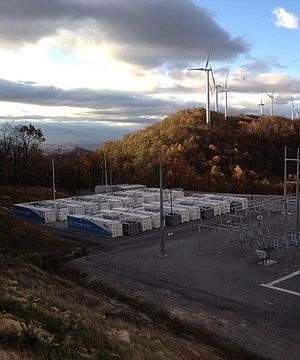Energy Storage in Oregon

<< Back to: Green industry <<
Energy storage is often a problem with renewables. Utility power is designed to meet peak demand. Dams can store water and run 24/7, while coal and gas fired power plants can kick on to meet peak demand - but the sun and wind are not predictable.

The power system requires that generation of electricity perfectly matches the amount consumed at all times but wind farms can create excess power, causing waste or environmental impact or no power when you need it most.
Portland General Electric in the next two years plans to install batteries from Ener1 to supply enough juice to power 400 homes in Salem for about an hour. The Electric Storage Association has more on energy storage technologies.
AES Energy Storage, a Virginia-based subsidiary of the $17 billion global power giant, intends to offer utility-scale battery storage to Portland General Electric to help the utility bridge resource gaps and incorporate more renewable energy into its mix.
The utility is looking for approximately 200 MW of year-round flexible capacity to maintain reliability during peak demand and address the spikes and dives of wind, solar and other renewable energy. The utility is also looking for 150 MW that can peak in winter and 200 MW that can peak in both summer and winter.
What AES is proposing in an RFP is probably 200 MW of battery-based storage that would be an alternative to building a new gas-fired plant, which is the typical way that a utility will need to meet energy capacity needs,” said Praveen Kathpal, who leads Northwest development for AES Energy Storage.
Their sealed lithium-ion batteries, originally designed for buses, fill rows of 53-foot long shipping containers. Its first energy storage project, a 32-megawatt system is linked to a 98-megawatt West Virginia wind farm.
Energy can be stored locally (using batteries), but utility companies are looking into large scale storage alternatives such as underground storage of pressurized air, flywheels, or other techniques.

Grid-scale energy storage is a developing interest, since wind power is at the mercy of Mother Nature. Compressed air storage underground is one solution. Three fourths of the United States is said to have geology suitable for underground air storage. Wind turbines can pump air into underground storage, which is then retrieved when additional power is needed.
The Mist Gas Fields are used for both producing natural gas and storing it. The gas is found in relatively shallow pockets (2200 feet) with a solid dome above it and salt water below it. The geology is ideal for gas storage, and Northwest Natural has developed the site to do exactly that. Off peak gas is pumped into the ground during much of the year, and during the seasonal peaks, the compressors are reversed and the gas is recovered to augment regional supplies.
NEXT: Inverters and Electronics in Oregon
Back to: Green industry <<